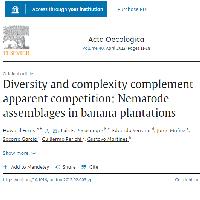Resumen
- The structure of communities of soil organisms, and, therefore, their ecosystem functions, respond to spatial and temporal changes in plant diversity and to subsidies of organic matter. We introduce the concept of amplifiable and target prey in directing the impact of shared predators on pest organisms. In soil nematode assemblages, rather than overt apparent competition between the two prey categories, the effects were more subtle and expressed as increased predation pressure on the target prey when resources for the amplifiable prey were greater. We conclude that the connectance complexity of the food web subverts resource flow through a sequential chain of trophic interactions so that interaction strength decreases at successive trophic exchange. However, the effect of resource diversion is that the net regulatory pressure on the target prey is potentially enhanced by the increase in alternate predators of each prey category. The system requires that certain criteria are met, including that predator populations are resource limited, that conditions are conducive for predator survival and increase, and that predators, amplifiable and target prey are co-located in a majority of patches associated with resource subsidy, favorable conditions or migration patterns.
